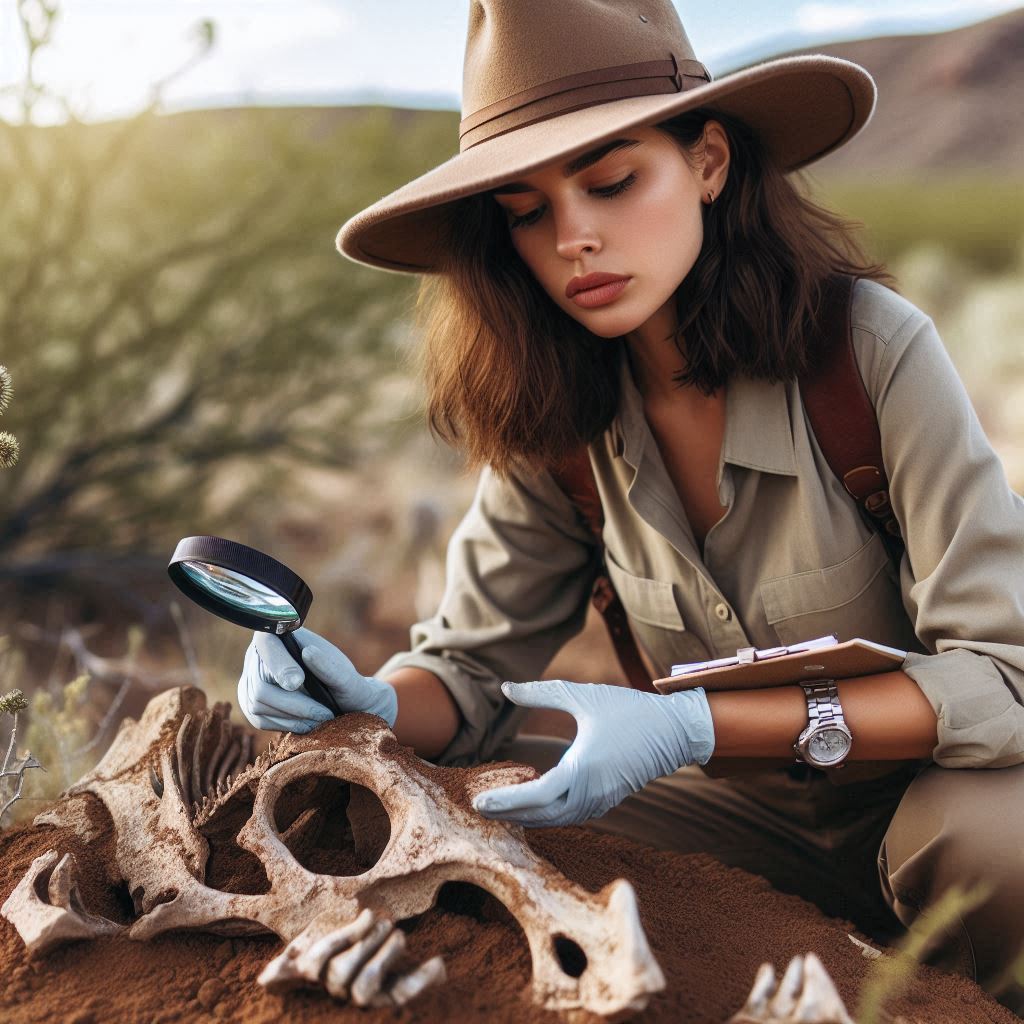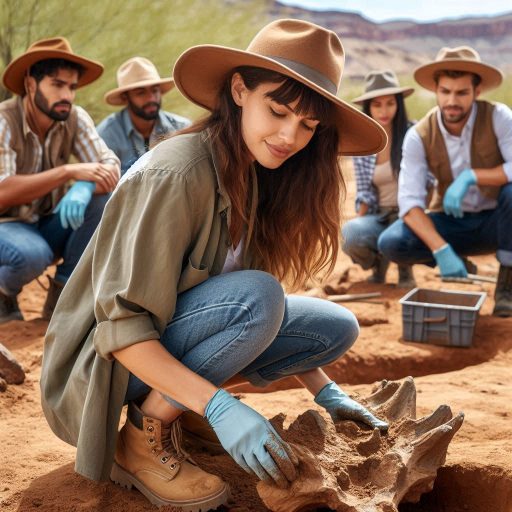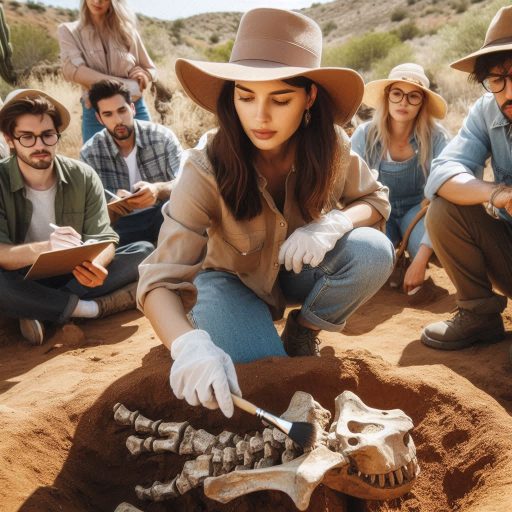Introduction
Women have played vital roles in archaeology throughout history.
Their contributions have shaped our understanding of past societies and cultures.
Despite facing significant challenges, women have made remarkable discoveries and advancements in the field.
Highlighting these contributions is crucial for several reasons.
First, it acknowledges the often-overlooked work of female archaeologists.
Recognizing their achievements helps to inspire future generations of women in science.
Furthermore, showcasing women’s roles promotes gender equality within the discipline.
It encourages a more inclusive perspective in archaeological research.
When we celebrate the successes of women in archaeology, we foster a richer, more diverse narrative of our shared past.
Understanding the challenges women have faced in archaeology also sheds light on the need for change.
Many barriers still exist, and addressing these issues is essential for progress.
By bringing attention to women’s contributions, we create opportunities for collaboration and mentorship.
This support is vital for empowering women in the field.
As we explore the history and present of women in archaeology, we recognize their invaluable impact and future potential.
Early Pioneers in Archaeology
Early Women Archaeologists and Their Contributions
Women have played a vital role in the field of archaeology since its inception.
Despite facing significant challenges, early female archaeologists made remarkable contributions.
Their pioneering work laid the groundwork for future generations of women in the discipline.
Gertrude Bell
Gertrude Bell stands out as one of the first women in archaeology.
She was an explorer, writer, and political officer in the early 20th century.
Bell conducted extensive archaeological surveys in the Middle East, particularly in Iraq.
She contributed to the creation of the Iraq Museum and documented ancient sites, enhancing our understanding of the region.
Her work went beyond archaeology; she influenced political decisions during the formation of modern Iraq.
Margaret Murray
Margaret Murray was another trailblazer in the field.
As an Egyptologist, she published influential works on ancient Egyptian burial practices and beliefs.
Her research focused on understanding the role of women in ancient societies.
Murray’s groundbreaking ideas challenged existing narratives, highlighting women’s contributions to religion and culture.
Despite her accomplishments, she faced skepticism and criticism from male colleagues.
Dorothy Garrod
Dorothy Garrod made significant strides in prehistoric archaeology.
She became the first woman to hold a professorship at Cambridge University.
Garrod’s excavations in the Middle East uncovered vital evidence about early human life.
Her work at Mount Carmel revealed information about Neanderthals and early modern humans.
She emphasized the importance of gender in archaeology and encouraged women to pursue careers in the field.
Challenges Faced by Women
Early women archaeologists faced numerous obstacles in a male-dominated field.
Many struggled for recognition and respect from their male counterparts.
They often lacked access to funding and institutional support.
Despite these barriers, these women persisted and made significant strides.
The societal expectations of the time limited women’s opportunities.
Many believed that archaeology was unsuitable for women.
Nevertheless, pioneers like Bell, Murray, and Garrod defied these norms.
Their determination and passion for archaeology led to significant contributions.
These early women opened doors for future generations.
They demonstrated that women could excel in archaeology despite societal constraints.
Their work continues to inspire young women today.
Early pioneers in archaeology played a crucial role in shaping the field.
Gertrude Bell, Margaret Murray, and Dorothy Garrod made significant contributions while overcoming challenges.
Their legacy empowers modern women archaeologists, proving that determination can lead to groundbreaking discoveries.
As we recognize their achievements, we must continue to support and promote diversity in archaeology.
Women in Modern Archaeology
Current Landscape of Women in Archaeology
Today, women play an increasingly vital role in archaeology.
Their contributions span various specializations, including fieldwork, research, and academia.
The modern archaeological landscape reflects greater gender diversity than ever before.
However, challenges remain as women strive for equal representation in leadership roles.
How Women Are Making Strides and Breaking Barriers in the Field
Women are breaking barriers in archaeology and redefining the field.
They are leading major excavations, directing research projects, and publishing influential studies.
Organizations and institutions actively promote gender equality.
Many programs now support women in archaeology through grants and mentorship opportunities.
These initiatives empower women to pursue their passions and excel in their careers.
Examples of Modern Female Archaeologists Making a Difference
Several modern female archaeologists are making significant strides in the field.
For example, Dr. Sarah Parcak is a pioneering archaeologist and space archaeologist.
She uses satellite imagery to locate and protect ancient sites.
Her innovative approach has led to the discovery of lost cities and sites in Egypt and other regions.
Parcak’s work has raised awareness about the importance of preserving cultural heritage.
Another prominent figure is Dr. Fiona Coward, a leader in prehistoric archaeology.
Her research focuses on human evolution and the origins of modern behavior.
Coward’s work contributes to our understanding of early human societies and their adaptations.
She actively encourages young women to engage in archaeology through outreach and education programs.
Dr. Jodie Lewis is another noteworthy archaeologist making an impact.
She specializes in maritime archaeology and studies underwater cultural heritage.
Lewis has worked on significant projects exploring shipwrecks and submerged sites.
Her research emphasizes the importance of protecting maritime resources and promoting public awareness.
Women in archaeology are fostering a supportive and inclusive community.
Many female archaeologists collaborate on interdisciplinary projects and mentor each other.
They create networks that empower women and promote diversity in the field.
This shift towards inclusivity enriches archaeological research and enhances collaboration.
Organizations like the Society for American Archaeology actively promote gender equity.
They offer resources, workshops, and forums to address gender-related issues in archaeology.
Such efforts help to create a more equitable environment for women.
Women in modern archaeology are making significant strides and breaking barriers.
Through their leadership, innovation, and dedication, they contribute to the field’s growth.
Figures like Dr. Sarah Parcak, Dr. Fiona Coward, and Dr. Jodie Lewis inspire future generations.
They demonstrate that women can excel in archaeology and make a difference.
Read: Top Skills Needed for a Successful Geology Career
Challenges Faced by Women in Archaeology
Obstacles That Women Continue to Face in the Field
Despite progress, women in archaeology face numerous challenges.
Gender bias remains a significant issue, often affecting career advancement.
Women frequently encounter stereotypes that undermine their expertise and contributions.
These biases can manifest in hiring practices and project leadership opportunities.
As a result, many talented women struggle to gain recognition in the field.
Issues Such as Gender Bias, Wage Gaps, and Work-Life Balance Struggles
The wage gap between male and female archaeologists persists.
Women often earn less than their male counterparts for similar work.
This discrepancy discourages many from pursuing long-term careers in archaeology.
Additionally, women face challenges in achieving work-life balance.
Fieldwork often requires long hours in remote locations, making it difficult to maintain family responsibilities.
Many women in archaeology report feeling pressured to choose between career advancement and family life.
This pressure can lead to burnout and frustration.
Women may also experience isolation in male-dominated work environments, impacting their mental well-being.
The lack of supportive policies, such as maternity leave, further exacerbates these issues.
Need for More Support and Advocacy for Female Archaeologists
The archaeological community must advocate for systemic change to address these challenges.
Institutions should implement policies that promote gender equality.
Offering flexible work schedules can help women balance their professional and personal lives.
Organizations can also provide mentorship programs to support women in their careers.
Creating networks for female archaeologists fosters collaboration and empowerment.
These networks can help women share experiences, resources, and opportunities.
Advocacy groups can raise awareness about the importance of gender equity in archaeology.
Academic institutions play a critical role in addressing these challenges.
They should promote diversity in hiring practices and support research on gender issues.
Offering scholarships and grants specifically for women can help increase their representation in archaeology.
Women in archaeology face significant challenges, including gender bias, wage gaps, and work-life balance struggles.
These obstacles hinder career advancement and affect mental well-being.
Addressing these issues requires systemic change within the archaeological community.
Increased support, advocacy, and awareness are essential for creating an equitable environment.
By promoting gender equality, the field of archaeology can benefit from diverse perspectives and experiences.
Ultimately, fostering an inclusive culture will enrich archaeological research and ensure a brighter future for all.
Read: The Future of Botany: Emerging Fields and Innovations
Intersectionality in Archaeology
Importance of Considering Intersectionality in the Field of Archaeology
Intersectionality is crucial in understanding women’s experiences in archaeology.
This concept considers how various identities, including race and ethnicity, shape individuals’ lives.
It acknowledges that different forms of discrimination often overlap, creating unique challenges.
For women of color, these intersections significantly impact their professional journeys in archaeology.
The field must recognize and address these complexities to foster inclusivity.
How Race, Ethnicity, and Other Factors Impact Women’s Experiences in the Field
Women of diverse racial and ethnic backgrounds often face additional barriers in archaeology.
Stereotypes can limit their opportunities and undermine their contributions.
These women may experience microaggressions, leading to feelings of isolation.
Cultural expectations can also create challenges, as women navigate their identities in predominantly white spaces.
Consequently, women of color often struggle to find mentorship and support.
Disparities in representation further complicate their experiences.
Underrepresentation can lead to a lack of role models, hindering professional growth.
Women from marginalized communities may also face difficulties in securing funding for research.
Limited access to resources can affect their ability to participate in archaeological projects.
Need for Diverse Representation in Archaeology
Diverse representation is essential for the future of archaeology.
Including individuals from various backgrounds enriches research perspectives and methodologies.
It fosters a more comprehensive understanding of human history.
Diverse teams can challenge prevailing narratives and promote inclusivity in archaeological interpretations.
By incorporating multiple viewpoints, archaeology can better reflect the societies it studies.
Archaeological institutions should prioritize diversity in their hiring practices.
They must actively seek out candidates from underrepresented backgrounds.
Training programs can also raise awareness about the importance of intersectionality in the field.
Education and outreach initiatives can encourage marginalized groups to pursue careers in archaeology.
Furthermore, collaboration with local communities enhances research outcomes.
Engaging with diverse voices allows for a more accurate representation of heritage.
It fosters relationships based on trust and mutual respect, benefiting both archaeologists and communities.
Intersectionality plays a vital role in understanding women’s experiences in archaeology.
Race, ethnicity, and other factors create unique challenges for women of color.
Addressing these issues requires commitment to diversity and inclusion within the field.
By prioritizing diverse representation, archaeology can enrich its research and better reflect the complexities of human experience.
Ultimately, embracing intersectionality will lead to a more equitable and innovative archaeological practice.
Read: What Does a Geologist Do? Career Overview and Insights

Mentorship and Support for Women in Archaeology
Benefits of Mentorship and Support Networks for Women in the Field
Mentorship plays a crucial role in empowering women in archaeology.
A mentor provides guidance, encouragement, and support throughout one‘s career.
This relationship helps women navigate challenges and build confidence.
Additionally, mentorship fosters professional growth by sharing valuable knowledge and experiences.
Support networks create a sense of belonging, which is vital in a male-dominated field.
Connecting with peers allows women to share experiences and challenges openly.
These networks can lead to collaborations and new opportunities.
Furthermore, mentorship enhances career advancement for women in archaeology.
A mentor‘s endorsement can open doors to research projects and job opportunities.
Women who have mentors often report higher job satisfaction and career success.
These benefits contribute to a more balanced representation in the field.
By fostering strong relationships, mentorship helps break down barriers for women.
Transform Your Career Today
Unlock a personalized career strategy that drives real results. Get tailored advice and a roadmap designed just for you.
Start NowRole of Organizations and Initiatives That Promote Gender Equality in Archaeology
Several organizations advocate for gender equality in archaeology.
Groups like the Society of American Archaeology (SAA) promote diversity and inclusion.
They offer resources to support women in the field, such as workshops and conferences.
Initiatives like Women in Archaeology aim to raise awareness about gender issues.
These organizations also provide networking opportunities, helping women connect with mentors and peers.
In addition, funding opportunities targeted at women in archaeology can alleviate financial barriers.
Grants specifically for female archaeologists encourage research and innovation.
By prioritizing gender equality, organizations can help create a more inclusive environment.
Successful Mentorship Programs and Resources Available for Female Archaeologists
Many successful mentorship programs exist to support women in archaeology.
For example, the Archaeological Institute of America offers mentorship initiatives that connect students with experienced professionals.
These programs facilitate valuable relationships, enhancing participants‘ careers.
Similarly, the Women‘s Archaeology Network provides resources and support for female archaeologists.
Online platforms also offer valuable resources.
Websites like Archaeology.org feature articles, forums, and webinars focusing on women‘s issues in the field.
These platforms provide essential information and networking opportunities.
Social media groups also allow women to share experiences and seek advice.
This interconnectedness fosters a supportive community that empowers women.
Mentorship and support networks are vital for women in archaeology.
They provide essential guidance, foster connections, and promote professional growth.
Organizations and initiatives focused on gender equality help create a more inclusive environment.
By highlighting successful mentorship programs and available resources, the archaeological community can empower women.
Supporting women in archaeology leads to a richer, more diverse understanding of our shared past.
Embracing mentorship and support ultimately strengthens the discipline and ensures its future success.
Read: Educational Path: Becoming a Geologist in the USA
See Related Content: Innovative Materials Discoveries Changing the World
Celebrating Women’s Achievements in Archaeology
Some of the Most Notable Achievements of Women in Archaeology
Women have made significant contributions to archaeology throughout history.
Their achievements span groundbreaking discoveries, influential publications, and leadership roles.
Notable female archaeologists like Kathleen Kenyon transformed our understanding of ancient civilizations.
Kenyon‘s excavations at Jericho revealed critical insights into early urban development.
Her meticulous work set new standards for excavation techniques.
Another influential figure, Mary Leakey, made remarkable discoveries in East Africa.
Leakey‘s work at Laetoli uncovered hominid footprints, proving early humans walked upright.
This discovery provided essential evidence about human evolution.
Her findings reshaped our understanding of prehistoric life and behaviors.
Leakey’s legacy continues to inspire generations of archaeologists.
Groundbreaking Discoveries, Publications, and Leadership Roles Held by Female Archaeologists
Female archaeologists have also produced influential publications that shaped the field.
For instance, Margaret Murray authored “The Splendor That Was Egypt,” which explored ancient Egyptian civilization.
Her scholarship helped popularize Egyptology and inspired further research.
Similarly, Dorothy Garrod, the first female professor of archaeology at Cambridge University, made significant contributions to prehistoric archaeology.
Her work focused on early human life in the Near East.
Women also hold essential leadership roles in various archaeological organizations.
For example, Dr. Patricia L. Crown served as the president of the Society for American Archaeology.
Her leadership has inspired numerous initiatives promoting inclusivity and diversity in archaeology.
Women in leadership roles continue to advocate for equal representation and mentorship opportunities.
Importance of Recognizing and Celebrating Women’s Contributions to the Field
Recognizing women’s achievements in archaeology is crucial for inspiring future generations.
Celebrating these accomplishments encourages young women to pursue careers in the field.
When we acknowledge the contributions of female archaeologists, we promote a more inclusive narrative.
This recognition helps dismantle stereotypes and challenges gender biases in the profession.
Furthermore, celebrating women’s achievements fosters a sense of community within archaeology.
It highlights the diverse perspectives that women bring to the discipline.
Their insights and approaches enrich our understanding of the past.
Promoting women’s contributions also paves the way for future research and exploration.
Women have made extraordinary achievements in archaeology, shaping the field significantly.
From groundbreaking discoveries to influential publications, their impact is profound.
By celebrating these contributions, we acknowledge their importance and inspire future generations.
This recognition leads to a more equitable and diverse archaeology, ultimately enhancing our understanding of human history.
Supporting women in the field ensures that archaeology continues to thrive and evolve.
Future Outlook for Women in Archaeology
Progress That Has Been Made in Gender Equality in Archaeology
In recent years, archaeology has made significant strides toward gender equality.
More women now occupy leadership positions in archaeological institutions.
Organizations actively promote diversity and inclusion, creating a more supportive environment.
Increasingly, women receive funding for research and fieldwork opportunities.
These changes reflect a growing recognition of women’s contributions to the discipline.
Many universities have implemented programs encouraging women to pursue archaeology.
These initiatives help create a more balanced gender representation in academic settings.
As a result, the number of female students in archaeology programs has risen.
This progress signals a positive trend toward equal representation.
Opportunities for Further Advancement and Empowerment of Women in the Field
Further advancement for women in archaeology remains essential.
Mentorship programs play a crucial role in supporting female archaeologists.
Experienced archaeologists can guide younger professionals through challenges.
These programs help women build networks and gain confidence in their work.
Moreover, organizations should continue advocating for gender equality in funding opportunities.
Providing grants specifically for female archaeologists can encourage innovative research.
Women should also be actively involved in decision-making processes within archaeological institutions.
Their insights can shape policies that promote a more inclusive environment.
Expanding outreach to diverse communities can also empower women.
Engaging local communities can increase awareness of the importance of archaeology.
This approach fosters collaboration and inclusivity, enriching the discipline.
Potential Challenges and Areas for Improvement in Promoting Diversity and Inclusion in Archaeology
Despite progress, challenges still exist for women in archaeology.
Gender bias persists in hiring and promotion processes.
Many women experience barriers when seeking leadership roles.
Addressing these biases requires ongoing education and awareness efforts.
Additionally, wage gaps continue to affect women in the field.
Research shows that female archaeologists often earn less than their male counterparts.
Organizations must actively work to rectify these disparities.
Implementing transparent salary structures can help promote fairness.
Work-life balance remains another significant challenge.
Many women juggle family responsibilities with their professional commitments.
Providing flexible work arrangements can alleviate some of these pressures.
Archaeological institutions should prioritize policies that support work-life balance.
The future outlook for women in archaeology is promising yet requires ongoing effort.
Progress in gender equality reflects a growing awareness of women’s contributions.
Opportunities for advancement and empowerment are increasing, but challenges persist.
By addressing these issues, the field can foster a more inclusive environment.
Promoting diversity and inclusion will strengthen archaeology and enrich our understanding of the past.
Together, we can create a brighter future for women in archaeology.
Conclusion
This blog post highlighted the essential role of women in archaeology.
We explored the significant contributions of early pioneers and modern leaders.
We discussed the ongoing challenges women face in the field, including gender bias and wage gaps.
Recognizing women’s achievements is crucial for promoting gender equality in archaeology.
Mentorship programs and support networks play vital roles in empowering female archaeologists.
Additionally, advocating for diversity and inclusion will enhance the discipline.
We must acknowledge intersectionality and consider the diverse experiences of women in archaeology.
Creating an inclusive environment benefits everyone and enriches our understanding of the past.
As we move forward, let us continue advocating for women in archaeology.
Institutions and organizations should commit to providing equal opportunities and resources.
By fostering a supportive community, we can encourage more women to join the field.
Empowering female archaeologists will lead to innovative research and groundbreaking discoveries.
Together, we can ensure that women’s voices are heard and celebrated in archaeology.
The future of the field depends on our commitment to diversity and inclusion.
Let’s work together to promote a more equitable landscape for women in archaeology.
[E-Books for Sale]
The Big Book of 500 High-Paying Jobs in America: Unlock Your Earning Potential
$19.99 • 500 High-Paying Jobs • 330 pages
Explore 500 high-paying jobs in America and learn how to boost your career, earn more, and achieve success!
See All 500 High-Paying Jobs of this E-Book
1001 Professions Without a Degree: High-Paying American Jobs You Can Start Now
$19.99 • 1001 Professions Without a Degree • 174 pages
Discover 1001 high-paying jobs without a degree! Unlock career tips, skills, and success strategies for just $19.99!




